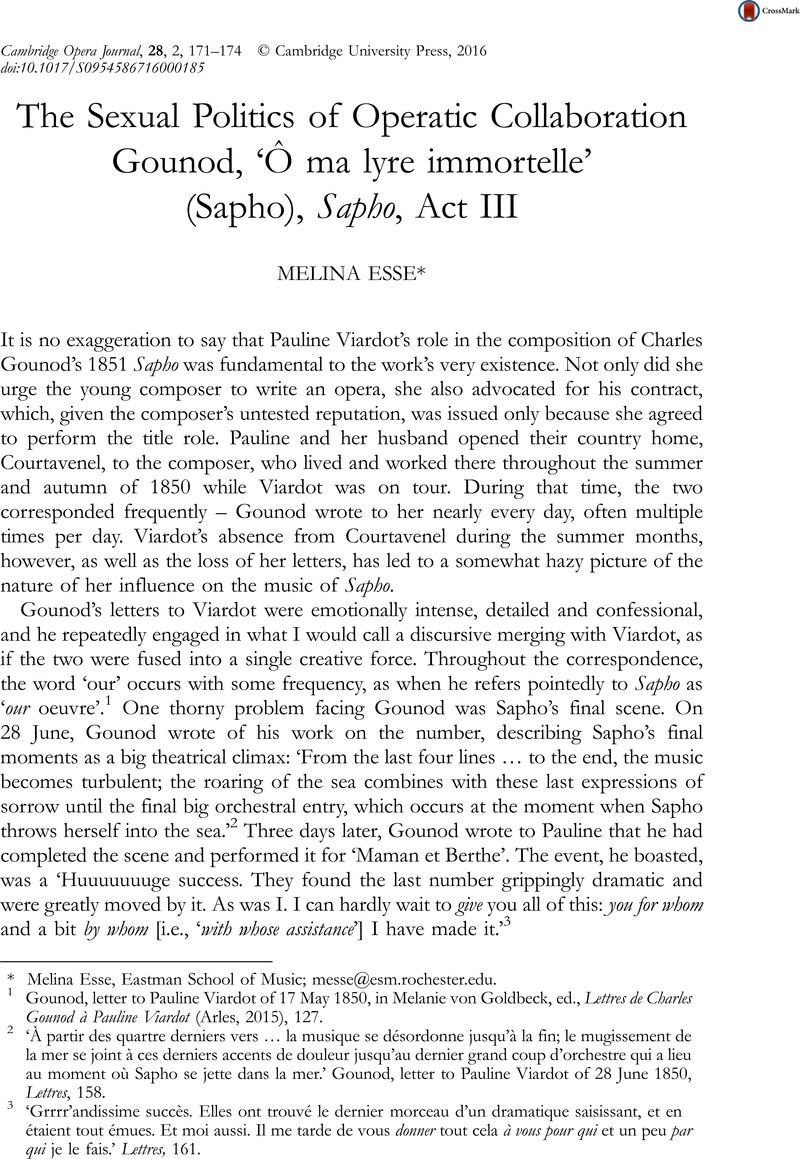Article contents
The Sexual Politics of Operatic Collaboration Gounod, ‘Ô ma lyre immortelle’ (Sapho), Sapho, Act III
Published online by Cambridge University Press: 28 September 2016
Abstract

- Type
- Research Article
- Information
- Cambridge Opera Journal , Volume 28 , Special Issue 2: Special Issue: Remaking the Aria , July 2016 , pp. 171 - 174
- Copyright
- © Cambridge University Press 2016
Footnotes
Melina Esse, Eastman School of Music; messe@esm.rochester.edu.
References
1 Gounod, letter to Pauline Viardot of 17 May 1850, in von Goldbeck, Melanie, ed., Lettres de Charles Gounod à Pauline Viardot (Arles, 2015), 127 Google Scholar.
2 ‘À partir des quartre derniers vers … la musique se désordonne jusqu’à la fin; le mugissement de la mer se joint à ces derniers accents de douleur jusqu’au dernier grand coup d’orchestre qui a lieu au moment où Sapho se jette dans la mer.’ Gounod, letter to Pauline Viardot of 28 June 1850, Lettres, 158.
3 ‘Grrrr’andissime succès. Elles ont trouvé le dernier morceau d’un dramatique saisissant, et en étaient tout émues. Et moi aussi. Il me tarde de vous donner tout cela à vous pour qui et un peu par qui je le fais.’ Lettres, 161.
4 Louis Viardot to Pauline Viardot, Courtavenel, 2 August 1850. MS Mus 264 (64), Houghton Library, Harvard University.
5 The original French for the passages quoted is as follows: ‘il avait un grand défaut’; ‘Le chant de désespoir de Sapho doit être d’un grand et terrible effet – je crois du moins que tu le feras ainsi’; ‘désespoir insensé et furieux’; ‘un joueur qui se suicide’; ‘Gounod n’a pas hésité à me croire, et s’en applaudit’. I am indebted to Ralph Locke for his assistance with deciphering and translating this letter.
6 Harding reports that she learned the entire score in just a few days – well enough to ‘accompany nearly all of it by heart at the piano’, a feat that impressed Gounod; see Harding, James, Gounod (New York, 1973), 63–64 Google Scholar.
7 Composed in 1841. Another existing song, Gounod’s ‘Le soir’ (text by Lamartine) from 1840, was used for Sapho’s ode in Act I.
8 ‘Le Lamento sera mis, c’est décidé, mais alors comme morceau purement lyrique, comme dernier chant de Sapho. La lyre en main, elle dira adieu à Phaon, au soleil, à sa lyre, à sa vie enfin, et s’en ira piquer sa tête et se noyer dans les larmes qu’elle aura fait verser au spectateur.’ Viardot, letter to Ivan Turgenev dated 10–15 Sept 1850, cited in Friang, Michèle, Pauline Viardot au miroir de sa correspondance (Paris, 2008), 108 Google Scholar.
9 Gérard Condé has recently argued that the letters leave some room for the possibility that Gounod might have made the decision himself ( Condé, , Charles Gounod (Paris, 2009), 206 Google Scholar); but he suggests that the composer likely destroyed Viardot’s letters to hide traces of their collaboration (Lettres, 16).
10 Waddington’s, Patrick article on ‘Pauline Viardot-Garcia as Berlioz’s “counselor and physician”’ (Musical Quarterly 59 (1973), 382–398 CrossRefGoogle Scholar) during the revision of Gluck’s Orphée certainly makes it clear that this was a familiar pattern for the singer.
11 Indeed, Beatrix Borchard has called Viardot an ‘anti-diva’ for the ways both accidents of birth (her appearance, her status as a younger sister to Malibran) and personal preference (her desire to be a concert pianist, her intellectual and studious bent) may have led the singer to critique the institution of diva-hood from within. Borchard, , ‘Eine “Anti-Diva”? Zur Rezeption Pauline Viardot-Garcias im 19. Jahrhundert’, in Diva – Die Inszenierung der übermenschlichen Frau. Interdisziplinäre Untersuchungen zu einem kulturellen Phänomen des 19. und 20. Jahrhunderts, ed. Rebecca Grotjahn, Dörte Schmidt and Thomas Seedorf (Schliengen, 2011), 114–125 Google Scholar.
- 1
- Cited by




